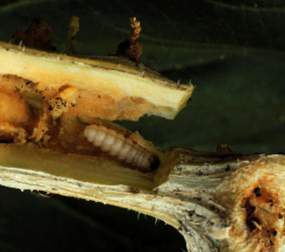
Karen Delahaut, formerly UW-Madison Fresh Market Vegetable Program
Revised: 1/9/2005
Item number: XHT1136
The squash vine borer (Melittia cucurbitae) is an annual pest of pumpkins and squash. This insect is often not recognized as a potential pest, but can be economically important in some years. Winter squash is highly susceptible to attack.
Appearance: The adult squash vine borer is a day-flying clearwing moth that resembles a wasp. The forewings of the moth are greenish-brown while the hindwings are transparent with a fringe of reddish-brown hairs. The wingspan of the insect is 1 1∕4 to 1 1∕2 inches. The moth’s body is rusty orange with black bands on the abdomen. Borers are wrinkled and white with brown head capsules. Larvae are 1 1/2 to two inches long at maturity.
Symptoms and Effects: Damage caused by squash vine borer larvae often goes undetected until infested plants wilt and die in late July and August. The first symptom of feeding damage is when plants wilt midday. This wilting is caused by larvae as they tunnel through vines and destroy the tissue that transports water. Wilt symptoms may be confused with those caused by bacterial wilt or Fusarium wilt. To distinguish between squash vine borer injury and these diseases, look for entrance holes near the base of wilting vines. If frass (i.e., feces) is present near the entrance holes, split the stem lengthwise to confirm the presence of larvae. Fields that have been damaged in the past are likely to be damaged again.
Life Cycle: Squash vine borers overwinter as pupae in the soil. They emerge as moths in late June and July, when 900 degree day 50 have been reached. This coincides with full bloom of the common roadside weed chicory. Female moths lay small, brown eggs at the base of plants. Once the eggs hatch seven to 10 days later, the larvae immediately begin burrowing into vines where they feed for 14 to 30 days. As larvae feed they leave behind a characteristic light brown frass (i.e., feces) that resembles sawdust. Fully grown larvae leave the plant to pupate. There is one generation per year.
Control: Currently there are no treatment thresholds for the squash vine borer. However, pumpkin and squash plants should be monitored once 900 degree day 50 have accumulated. Larvae boring into a main stem will kill an entire plant, while those boring into a runner will only kill the runners, and not cause economic damage in larger plants. Two to three insecticide treatments, five to seven days apart during the three week egg-laying period around 1000 degree day 50 will control most of the larval borers before they burrow into vines and become protected by vine tissue. Treat plants with runners that are less than two feet long is particularly important. For a list of pesticides that will control squash vine borers, refer to UWEX publication Commercial Vegetable Production in Wisconsin. Floating row covers may also be used during the flight period of adult squash vine borers to prevent egg-laying on susceptible plants. Keep in mind however that blooming plants need bees to pollinate flowers. Therefore, row covers must be removed during blooming to allow bees access to plants.

Download Article





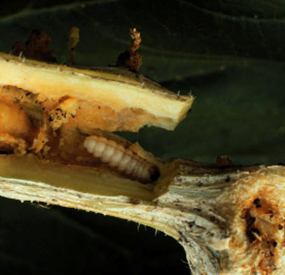 Squash Vine Borer
Squash Vine Borer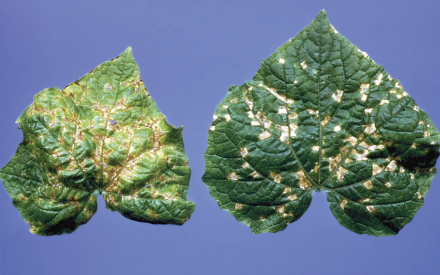 Vine Crops Disorder: Angular Leaf Spot
Vine Crops Disorder: Angular Leaf Spot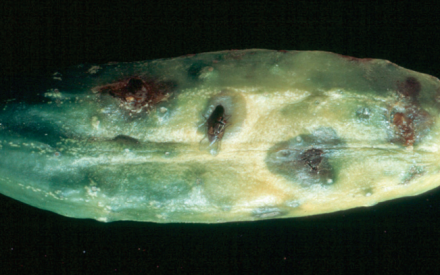 Vine Crops Disorder: Scab
Vine Crops Disorder: Scab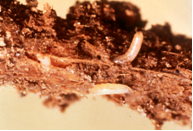 Degree Days for Common Fruit & Vegetable Insect Pests
Degree Days for Common Fruit & Vegetable Insect Pests


